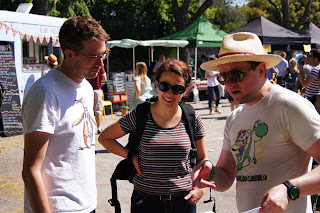 |
| 1. Early beginnings |
So the first day of the 'Cardboard City' went ahead and I would say it was a wonderful event to be a part of. As far as the photography went it took me a few attempts to get into my 'stride' but after that things went well. More specifically I took a lot of varied shots in keeping with what I had planned. This consisted firstly of me taking photographs that had a sense of place. This was achieved by almost always having some form of the cardboard city in the shot, be it in the foreground, background or even in a child's hand.
 |
| 2. The frameworks |
Secondly, I tried to mix up the lighting and framing while still making sure I kept a grasp of telling a story. This was, quite simply the growth of the cardboard city through people. In this regard I thought there was room for improvement on the lighting side of things. The story (in its beginnings) might have been more telling if the lighting had been consistent throughout. The framing worked well though, showing intelligibly what was happening in each shot as well as sometimes offering a bigger view of the proceedings. Also maybe I could have concentrated more on the beginnings of the cardboard city. This was because I didn't realise at the time how telling the first few hours of building the 'city' would be in regards to a narrative of the event. In retrospect I would say I didn't take a critical photograph of the 'city' while it was just past its 'infancy' but I did take a photograph either side. As the event will be taking place over several days I selected 4 images I thought best depicted the 'Cardboard City' at an early stage.
 |
| 4. A helpful contibutor |
 |
| 3. Building on the frame |
Lastly, I felt that as the day progressed I became more confident, which helped lots with the outcome of the photographs.
With the first photograph I attempted to convey how bare and lifeless the place was with just the hint of what was about to take place (there was only the first cardboard box of the city being laid). I thought this set up the series well with the natural lighting adding an air of fresh beginning. The photo also worked on its own in my opinion as the people in the background were grouped suggesting activity within the place would occur.
The second photograph was strong in terms of composition I felt as the triangles filled the frame well and connected the children with the cardboard material that would become prevalent within the rest of the photos. There was a lot of activity going on in the photograph as well but maybe if the girl holding the frame was looking up there would have been a bit more character.
In contrast I thought the third photograph showed lots of character as well as being well-composed. The girl on the left was clearly in the middle of helping to construct a part of the cardboard city and the lighting showed her face well. The mother on the right could possibly have been better lit (less shadows across her face) but overall it worked well. The low camera angle also offered a different and more immersive view.
Finally for this first day I deliberately waiteed until the boy (who was conscious of my presence) turned his head so I could capture his facial expression while still making the picture look 'natural'. Differing from the third photo, there was a lot of visible activity behind the boy, where in the third photo the two people were the main focal point. The only thing that could have been improved for me in this photograph was the boy could have been a bit more sharp- maybe the focus was slightly behind the boy.














































